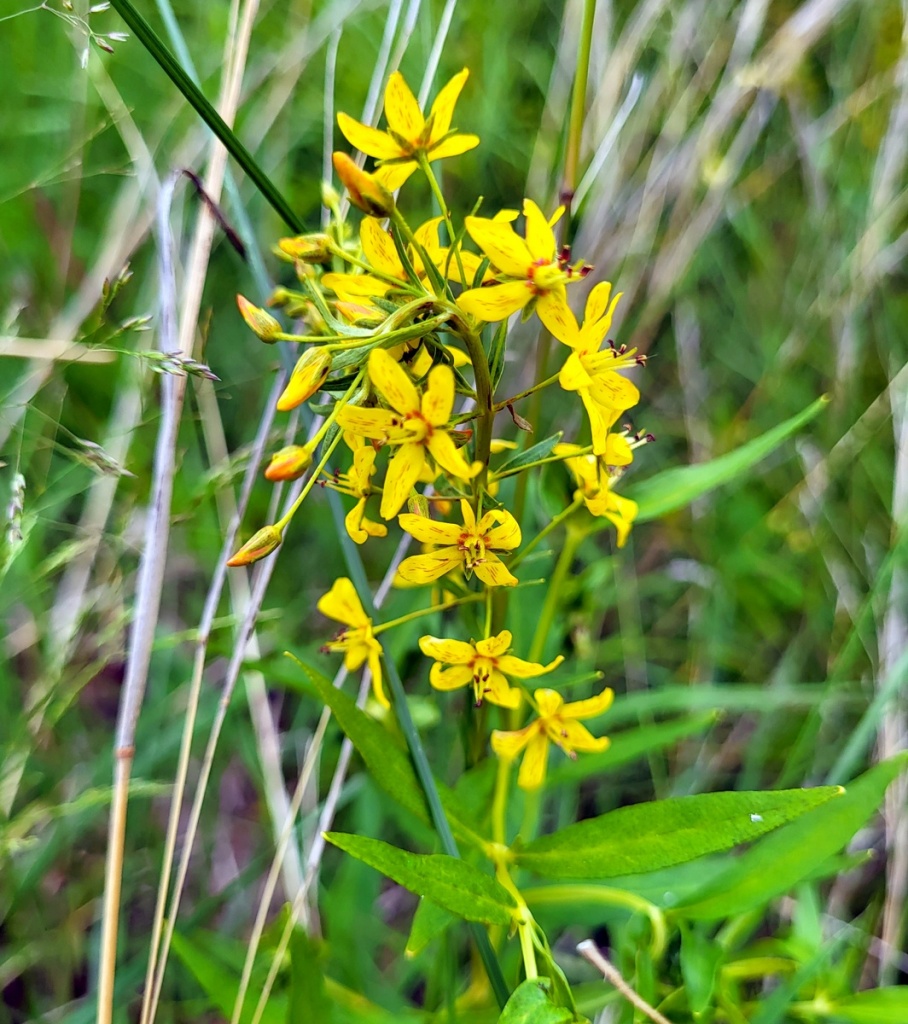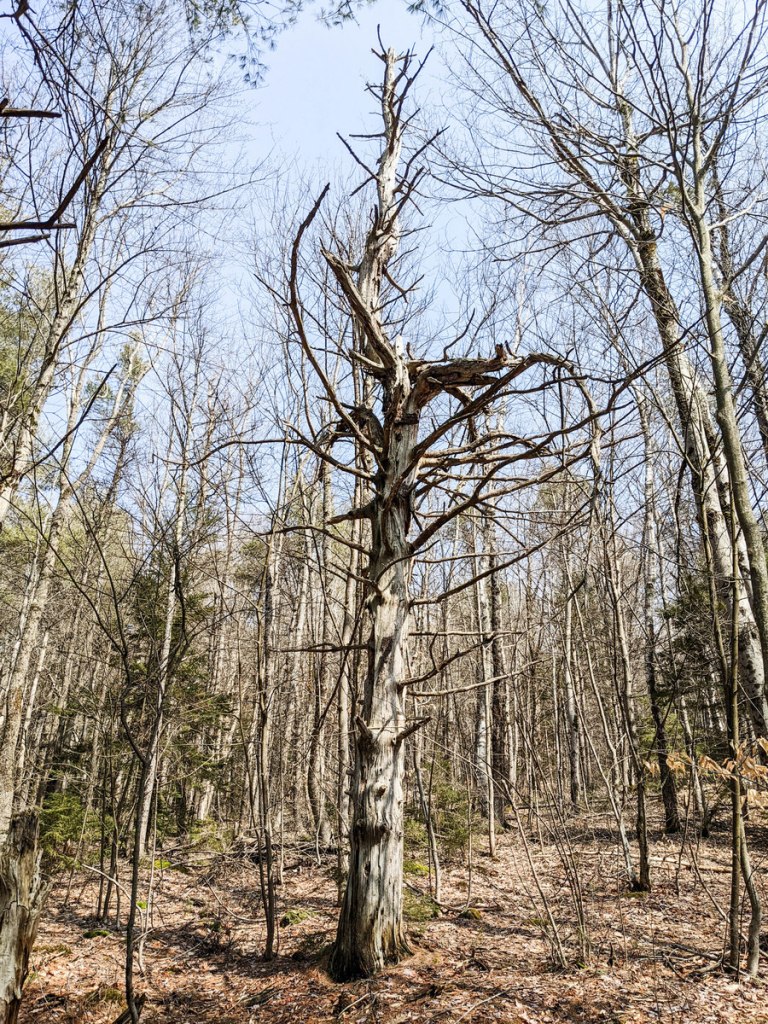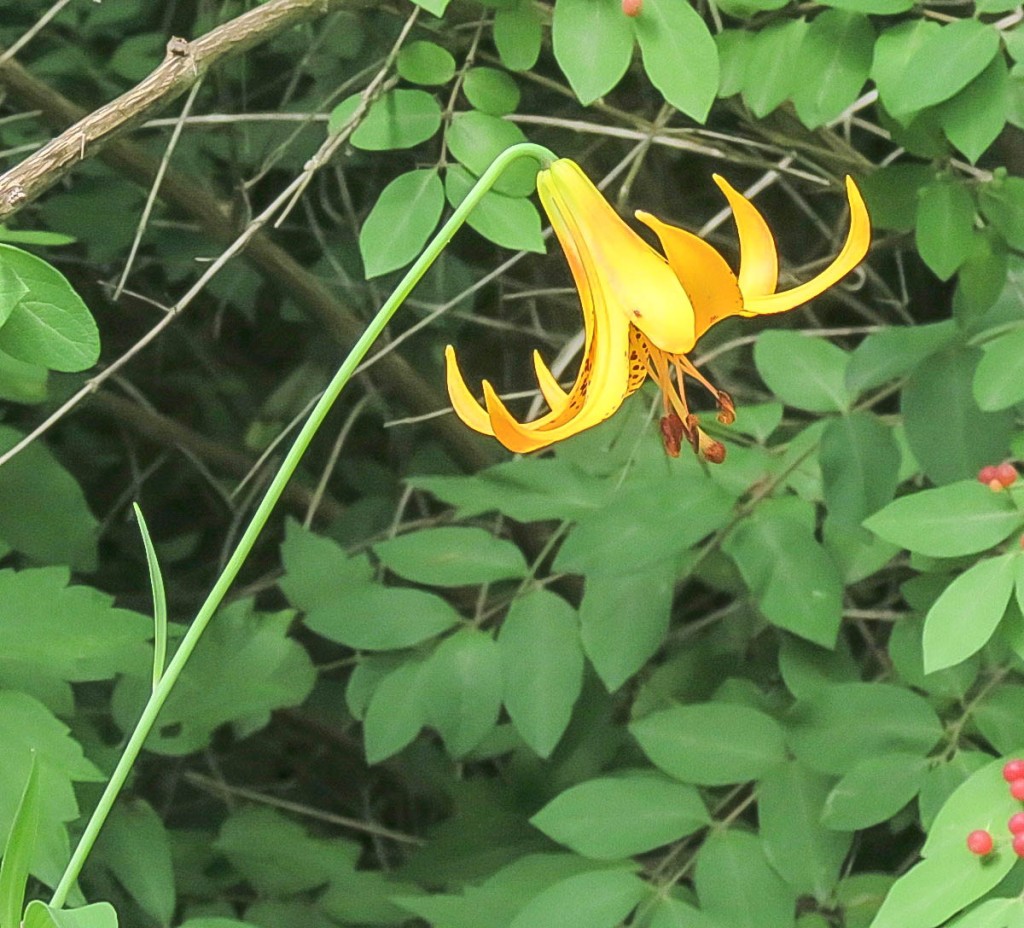
Right after I told you in that last post that crows flew away as soon as I pointed anything at them, this one landed in a tree right above me and posed for as many photos as I wanted to take. Even so I never did get a good one, but this reminded me once again that the words “always” and “never” have no place in nature study. As soon as you start thinking you have it all figured out nature shows you that you don’t.

After I walked down the trail for a few yards I stopped and looked back and saw the crow still sitting in the same place, looking as if it was admiring the red maple on the other side of the trail. I noticed that it kept looking over its shoulder and upwards so I wonder if there might have been a hawk nearby. There are cornfields very nearby so there are many squirrels living here. Because of that it has become a well known hawk hang out. The squirrels eat the corn and the hawks eat the squirrels and the crows hope everyone just leaves them alone.

The tree the crow was sitting in was a poplar. They have large, shiny buds that will open to reveal catkins that look almost like gray, fluffy, giant willow catkins. These bud scales were not sticky and that tells me this was a quaking aspen because that is the only member of the poplar family with buds like these that don’t have sticky bud scales. Balsam poplar buds look much the same but their brown bud scales are very sticky to the touch. I have touched huge numbers of poplar buds but only a few were sticky so we don’t seem to have a lot of balsam poplars in this immediate area.

The willows are going strong now with more buds opening every day. It won’t be long now before we see their beautiful, bright yellow flowers.

American hazelnut catkins are growing as well. I wanted to visit this particular rail trail because I know there are a lot of hazelnuts growing here. I had hoped to find some of the tiny female flowers but it got cold again after that last flowery post you saw, so spring flowers have been on hold for most of the week.

I saw a few hazelnuts that hadn’t been eaten but most were gone. At least a few have to fall to the ground and grow so future generations of birds and animals will have them.

I saw some beautiful leaves as well but I couldn’t be sure that they were hazelnut leaves. Hazelnut leaves will often stay red-brown all winter. They seem very warm on a cold February day.

Staghorn sumacs are covered in velvet like hairs like a deer’s antler, and when the light hits them in a certain way they glow as if lit from within. For the first time this year I noticed that cattails do the same.

A large mower had mowed the sides of the trail and when it did it scarred an older staghorn sumac, tearing its bark. This had most likely happened last fall and here was the inner bark turning bright red, just as I’ve seen it do so many times. As it ages it will slowly turn to gray but for now it’s beautiful. There is a lot of red in sumacs, including their beautiful fall color. Native Americans used all parts of this plant for everything from a kind of lemonade from its berries to dye from its bark and twigs.

I was surprised to find a wild privet with green leaves still on it out here. I grew up walking this trail when it was a working railroad and have never seen a privet here. I’ve read that birds love the berries so it will be appearing everywhere, I’m sure.

There are lots of grapevines along this trail and I always like to stop and have a look at the tendrils, wondering where my imagination might take me. It’s easy to get lost in this so you have to keep your wits about you so you don’t come down with a good case of tendrilitis. I can easily spend hours doing things like this. This one looked kind of like an S with an extra squiggle or top knot.

I went to where the trout lilies bloom so beautifully in the wetlands and saw what looked like a buck rub on an old alder. Since the way the alder grew would prevent a tractor or mower damaging it in this way, a buck rub is the only answer I could come up with.

A buck rub happens when a male deer rubs its antlers on a tree trunk or branch. It does this when the blood supply to its antlers decreases in the fall. The velvet on the antlers dries and begins peeling, and to get rid of it the deer rubs them on a tree or branch. It is also thought that this may be a way that young bucks practice fighting other young bucks. Quite often the same tree, or in this case a shrub, is used again and again, rubbing the bark right off it. Since I saw two bucks and four does in this area one day I suspect that this was probably a prime hunting spot before a public road was built very nearby.

As if to confirm my suspicions, here was an old tree stand; so old that it was falling apart. In those days they were built, not bought. Imagine sitting on that for hours on a cold fall morning, lashed to the tree, waiting for a deer to come by. It was a good choice though; that buck rub wasn’t too far from here.

The way the sunlight lit up this beech tree was so beautiful, I had to stop and take a photo of it. This is an example of why I often say beauty is everywhere you look. But you have to look, and you have to see. Unless you are power walking for exercise what harm could there be in just walking slowly and looking closely at your surroundings? When something captures your eye (or your heart) just go and see. And yes, looking is different than seeing. Anyone can look, but few seem to be able to really see. All it takes is a little practice.

I saw a very red colored seep. According to what I’ve read this red color in seeps and on river and stream banks is usually caused by iron hydroxide. A seep happens when ground water reaches the surface. It doesn’t flow; it just sits, and will usually stay in liquid form all winter without freezing.

There were lots of skunk cabbages in the seep with their mottled maroon and yellow spathes just starting to show. I went and saw the skunk cabbage with an open spathe that we saw in the last post, thinking I might see the flowers inside, but instead I found that the spathe had closed. That was a first; I’ve never seen them close their spathes before and have never heard that they could do so, but apparently if it gets cold enough they will. I think it got down to around 16 or 17 degrees F. on a couple of nights, so they must have closed up shop in a hurry. Plenty of plants get fooled in spring but I’ve never known skunk cabbages to fall for early warmth.

Lilac buds are getting big and beautiful now. Lilac buds normally have a natural whitish “glue” that keeps the overlapping bud scales from allowing water into the bud where it could freeze and kill the bud. These buds instead had this strip of tan (?) tissue on their leading edges, which was very pretty, I thought.

Yesterday it warmed up again in the afternoon and I must have seen two dozen dandelion blossoms. Here are two of them. Dandelions seem to be raring to go so far this year.

I can’t tell you how happy I was to see these two little yellow crocuses blossoming yesterday. Unfortunately it was supposed to get cold (23 degrees F) last night and it’s supposed to stay cold all of today, so there’s a good chance I won’t see them again. There are plenty more on the way though. As I said in the last post; once spring gets going there is no stopping it.
You must, in order that it shall speak to you, take a thing during a certain time as the only one that exists, as the only phenomenon which through your diligent and exclusive love finds itself set down in the center of the universe. ~Rilke
Thanks for stopping in.



















































































































































































































